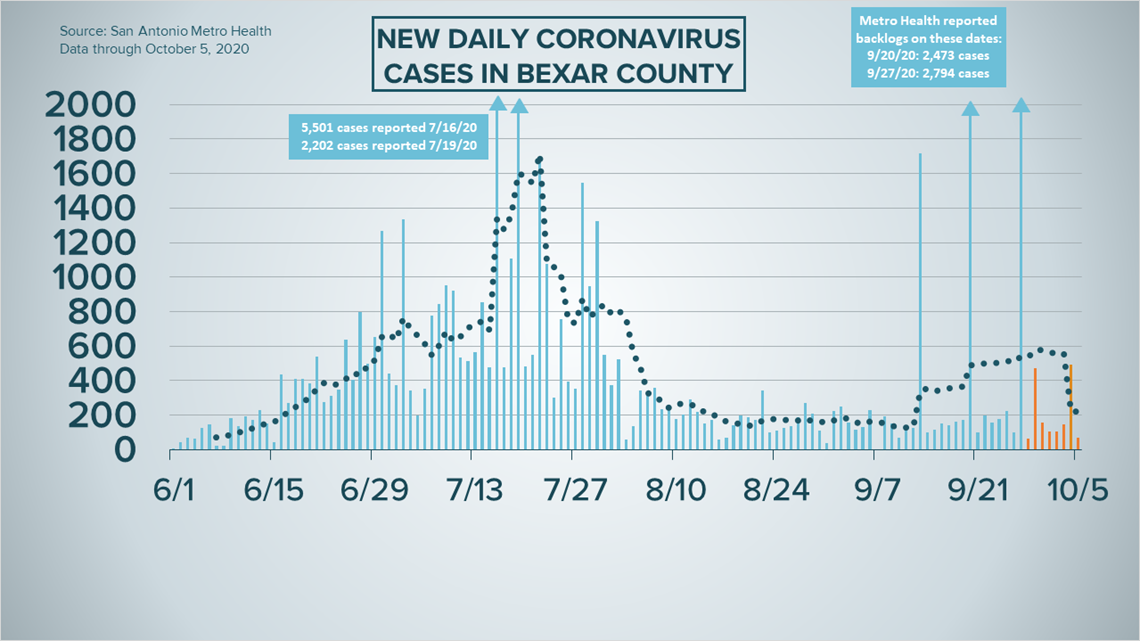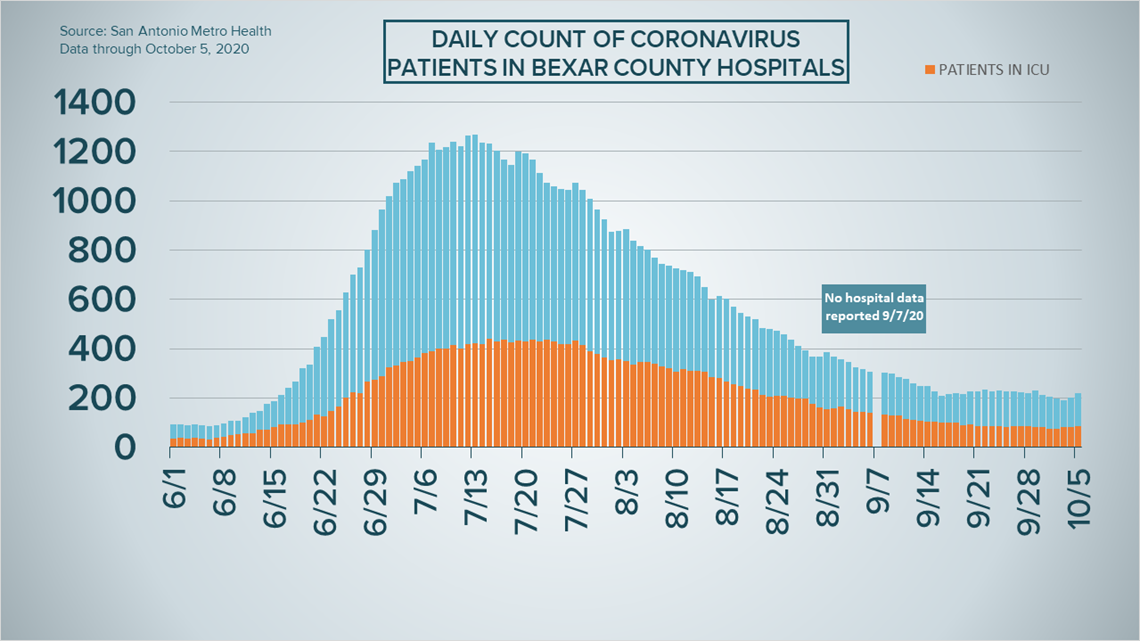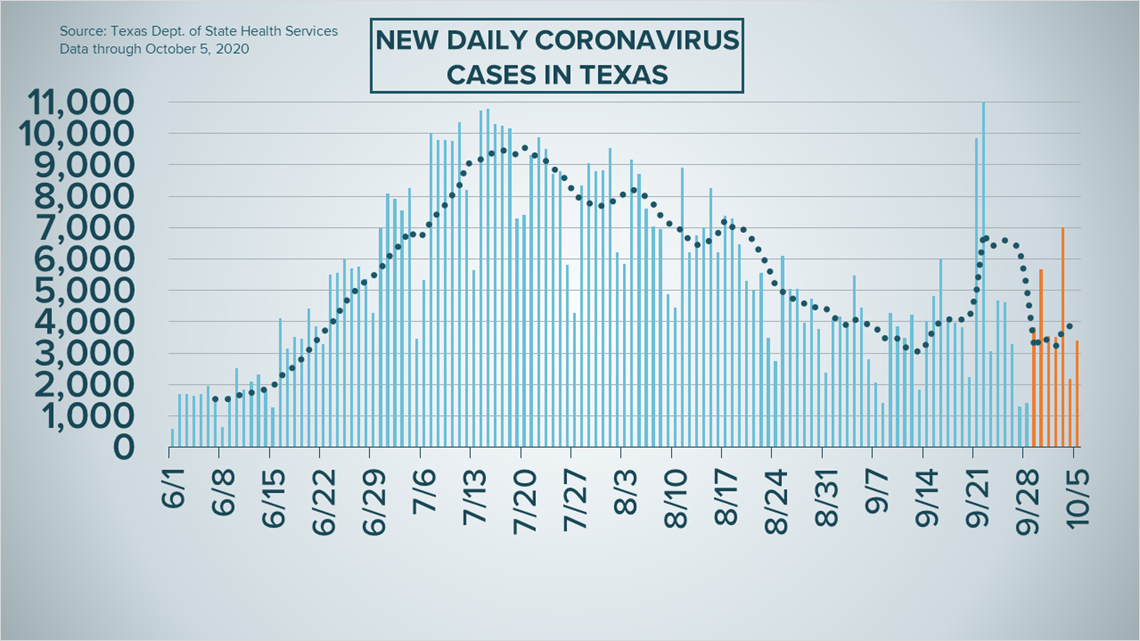SAN ANTONIO — We're tracking the latest numbers from the coronavirus pandemic in San Antonio and across Texas. Here are the latest numbers reported by Bexar and surrounding counties:
- Bexar County: 68 new cases were reported Monday, bringing the total number of cases for the county to 58,746. There were no new deaths, as the county's death toll remained at 1,167.
- Comal County: The county reported 14 additional cases on Tuesday and no additional deaths. There have been a total of 3,520 cases of COVID-19 in the county – including 2,761 confirmed cases – while 116 county residents have died. County officials say there are 100 active coronavirus cases, and 3,304 residents are considered recovered.
- Hays County: Officials in Hays County on Monday reported 14 new cases in the county and no additional virus-related deaths. As of Monday, there are a total of 5,965 lab-confirmed cases in the county (1,171 of which are active) while the death toll remains at 55. 4,739 residents have recovered from the virus.
How Bexar County is trending
We've tracked how many coronavirus cases have been confirmed in Bexar County from the time officials began reporting cases in March 2020. The graphic below shows the number of cases since June and charts those daily case numbers along a 7-day moving average to provide a more accurate picture of the overall coronavirus case curve in our area and the direction we're trending amid the pandemic.
On Monday, San Antonio Mayor Ron Nirenberg announced 68 new coronavirus cases in Bexar County, bringing the total to 58,746 Bexar County residents who have been diagnosed with the coronavirus since the pandemic began. The county's seven-day moving average has dropped to 136.


Officials reported no new deaths from virus complications; the death toll for the county remains at 1,167.
Hospitalizations rose slightly on Monday. According to Nirenberg, 219 people were receiving treatment for COVID-19 symptoms; that's 19 more than on Sunday.


Both the number of patients using ventilators (38 )and the number of patients in intensive care (86) rose Monday. 16 percent of staffed hospital beds remain available.
Bexar County remains at a "low" COVID-19 risk level, as the county's positivity rate dropped to below 5 percent. It's now 4.9%, just under the county's goal.
Watch Monday's coronavirus briefing below:
Coronavirus in Texas
The number of Texans who have tested positive for the coronavirus since the pandemic began grew by 3,409 cases on Sunday, according to the Texas Department of State Health Services.
2,192 of those are new diagnoses over the last 24 hours, while the other 1,217 cases stem from a number of backlogs in several counties and groups of previously unreported cases in some areas. More details can be found at the top of this page.


In total, 769,303 coronavirus cases have been confirmed in Texas.
State health authorities, meanwhile, reported an additional eight virus-related deaths on Sunday, the lowest number of reported fatalities in the state since June 15. At least 16,033 Texans have passed away from COVID-19 complications.


The state saw hospitalizations rise on Monday. There were 126 more Texans receiving treatment for coronavirus symptoms in the last 24 hours, for a total of 3,318 currently hospitalized.
The state estimates that 683,700 Texans have recovered, while 71,074 Texans remain ill with COVID-19.
Meanwhile, the Texas Education Agency updated its online coronavirus database to show that there have been 9,857 cumulative cases among staff and students across the state as of Sept. 27. More information can be found here.
Latest Coronavirus Headlines
- Hays County reports 1,171 active COVID-19 cases, 55 deaths
- Election Q&A: Is fear of contracting coronavirus an eligible reason to apply for a mail-in ballot?
- President Trump court nomination hangs over Senate shuttered by virus
- The differences, similarities of coronavirus versus flu
- Many Americans blame coronavirus crisis on US government, poll finds
- Increased level of domestic violence related to coronavirus, experts say
Coronavirus symptoms
The symptoms of coronavirus can be similar to the flu or a bad cold. Symptoms include fever or chills, cough, shortness of breath or difficulty breathing, fatigue, muscle or body aches, headache, new loss of taste or smell sore throat, congestion or runny nose, nausea or vomiting and diarrhea, according to the Centers for Disease Control.
Most healthy people will have mild symptoms. A study of more than 72,000 patients by the Centers for Disease Control in China showed 80 percent of the cases there were mild.
But infections can cause pneumonia, severe acute respiratory syndrome, kidney failure, and even death, according to the World Health Organization. Older people with underlying health conditions are most at risk.
But infections can cause pneumonia, severe acute respiratory syndrome, kidney failure, and even death, according to the World Health Organization. Older people with underlying health conditions are most at risk.
Experts determined there was consistent evidence these conditions increase a person's risk, regardless of age:
- Chronic kidney disease
- COPD (chronic obstructive pulmonary disease)
- Obesity (BMI of 30 or higher)
- Immunocompromised state (weakened immune system) from solid organ transplant
- Serious heart conditions, such as heart failure, coronary artery disease, or cardiomyopathies
- Sickle cell disease
- Type 2 diabetes
The CDC believes symptoms may appear anywhere from two to 14 days after being exposed.
Human coronaviruses are usually spread...
- Between people who are in close contact with one another (within about 6 feet).
- Through respiratory droplets produced when an infected person coughs, sneezes or talks. These droplets can land in the mouths or noses of people who are nearby or possibly be inhaled into the lungs.
- Some recent studies have suggested that COVID-19 may be spread by people who are not showing symptoms.
Help stop the spread of coronavirus
- Stay home when you are sick.
- Eat and sleep separately from your family members
- Use different utensils and dishes
- Cover your cough or sneeze with your arm, not your hand.
- If you use a tissue, throw it in the trash.

